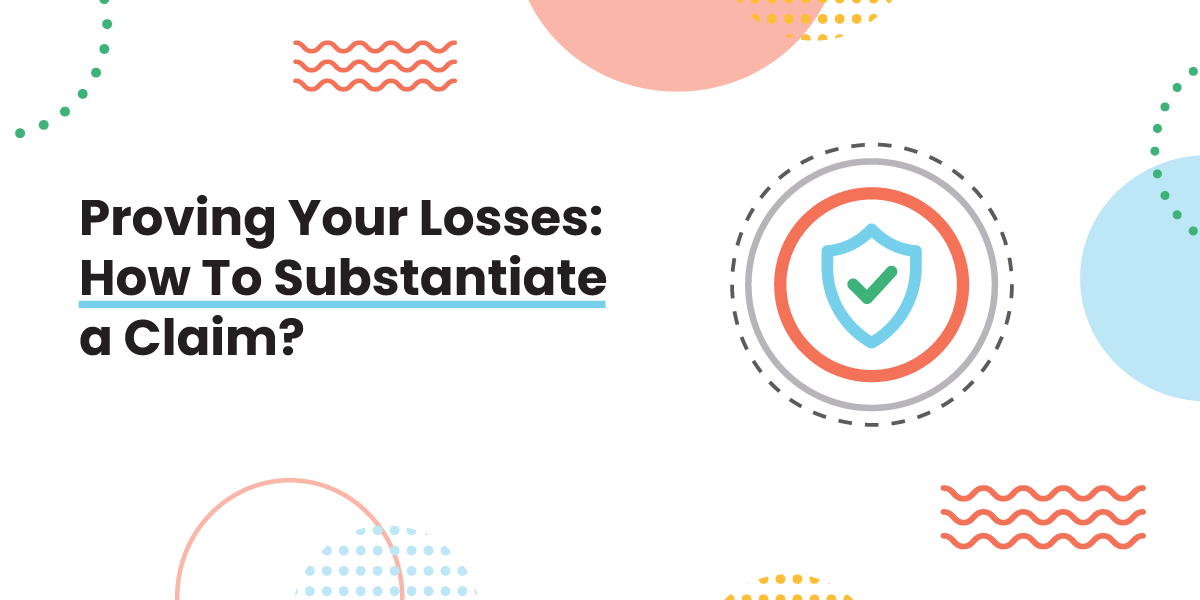Proving Your Losses: How To Substantiate a Claim
25 Feb 2022 • 5 min read

When you become a victim of a theft or hazard that causes severe damage to your expensive personal property, renters insurance comes to the rescue. However, to process your claim seamlessly, you need to ensure that you've got everything you need.
Once you understand what insurance providers look for, it is simple to gather all the information and documentation you need to file a strong claim.
For example, all insurance providers ask for some documentation as a body of evidence to prove the actual cost of the damage – this is where claim substantiation comes into play.
The word “substantiate” literally means providing evidence and strengthening an argument.
In the context of renters insurance, it means you can support your claim with adequate evidence in the form of receipts, pictures, and other relevant documents that can lead to reasonable interpretations of the claim.
Learn more about claim substantiation and how to substantiate a claim.
- Substantiate a Claim
- How To Substantiate a Claim With Ease
- What Happens After Substantiation?
- Final Thoughts: How To Substantiate a Claim in Case of an Emergency?
Substantiate a Claim
To substantiate a claim means strengthening the claim by providing documentation and credible evidence. In an emergency, you have to present sufficient records to give your insurance provider a clear idea of your losses.
As a general rule, all insurance providers require sufficient substantiation before processing a specific claim. So, whenever you encounter an emergency — in the form of theft or damage to your property — you will be expected to provide some evidence that can help in estimating the damages.
For example, if a specific type of product such as electronic equipment catches fire, you can submit the purchase receipts and pictures of the damaged items to substantiate your claim. You can prove you’re the item owner and get reimbursement, thus being safe from additional costs.
How To Substantiate a Claim With Ease
Substantiating a product claim is a relatively simple process if you follow specific steps, track your receipts and damages, and ensure proper documentation.
Create a Home Inventory
Creating a home inventory can save you from emergencies and damages that may occur in the future. You can track your existing items and estimate the losses if an issue arises.
It is always a good idea to keep a digital copy of your home inventory. It will save you from the hassle of carrying several documents and ensure your information is safe.
Make a List of Destroyed and Damaged Items
In case of damage or theft, one of the first things you should do is create a comprehensive list of damaged or stolen items. You should record all the damages and losses in this list, labeling the items with the financial estimates.
This step will help you file a claim, and the list will also serve as documented proof in substantiating the claim. Your claim will be based on more than anecdotal evidence because you've made this list.
Gather Documented Proof
Insurance providers require valid documentation for adequate substantiation. Make sure you have all the reliable evidence available when filing a claim. Documentation serves as reliable scientific evidence when substantiating a claim.
This documentation may include purchase receipts, police reports, pictures of damaged items, and email correspondence with your insurance provider. Tracking all documentation gives a reasonable basis to your claim and makes claim substantiation easy for you.
How To Gather Documentation Proof for Luxury Items
When gathering documentation for luxury items (e.g., designer bags and jewelry), things are slightly different.
Because of their increased cost compared to regular property, you need to take a few extra steps to demonstrate their value when substantiating a claim.
For items in this category, we suggest compiling these documents as your proof of purchase in case your insurance provider requests one (or more) of them when you file a claim:
- Receipts or invoices from the vendor. If the items were used by someone else before you bought them, you should ask for these documents from the original owner.
- Bill of sale. You should use this option if you buy a luxury item from a friend and a formal receipt is unavailable. You can create a simple bill of sale together with your friend. It should include the transaction details, such as the date of purchase, the item description, the purchase price, and your signatures.
- Photographs. Clear and detailed photos of the luxury item will provide a visual record of its condition at the time of purchase and any unique features that can help verify its authenticity and value.
- Authentication certificate. This is especially useful for items that could be mistaken as counterfeit. If you have an authentication certificate from the manufacturer or a reputable third-party authentication service, include a copy of that document.
- Communication records. If you have any text messages, emails, or other communication discussing the purchase, keep them as additional evidence.
Seek Clarification if Needed
If you’re unsure about any step or do not know how to substantiate a claim, contact your insurance provider. You can ask about your coverage and the insurance company's requirements for substantiating a claim.
You can also contact Goodcover. We’ll be happy to help you find the correct information so that you don’t suffer due to a lack of substantiation.
What Happens After Substantiation?
Goodcover simplifies claim substantiation for you. It varies the level of substantiation depending on the nature of your claim and the availability of receipts.
For example, Goodcover doesn’t expect you to provide receipts of items you’ve had for a long time. Instead, you can show ownership by sharing a picture of the item in a relevant area of your house.
After your implied claim is substantiated, Goodcover works with the North American Risk Services (NARS) to process your claim in a short timeframe. However, if you delay the substantiation process or provide insufficient evidence, the approval of your claim can get delayed.
Final Thoughts: How To Substantiate a Claim in Case of an Emergency?
It is always a good idea to prepare yourself for an emergency. Studies show that many people do not know the basics of insurance. Learning about claim substantiation and creating a home inventory is an excellent way to start these preparations.
These steps will help your insurance providers reach reliable results about your claim and make your claims authentic.
With Goodcover, you can get all the information you need when filing a claim and make substantiation a hassle-free process. The remarkable reviews and testimonials prove Goodcover's insurance is reliable and trustworthy.
Switch to a fair, modern, and cooperative insurance with Goodcover.
Get a quote today and secure your belongings.
Note: This post is meant for informational purposes, insurance regulation and coverage specifics vary by location and person. Check your policy for exact coverage information.
For additional questions, reach out to us – we’re happy to help.
More stories
Team Goodcover • 3 Apr 2024 • 6 min read
Goodcover’s Guide to Pennsylvania Landlord-Tenant Laws
Team Goodcover • 20 Mar 2024 • 7 min read
Goodcover’s Complete Guide to Renters Insurance in Atlanta, GA
Team Goodcover • 11 Mar 2024 • 6 min read
Goodcover’s Complete Guide to Renters Insurance in Houston
Team Goodcover • 29 Feb 2024 • 5 min read
Goodcover Reaches New Milestone; Now Serves Half of U.S. Renters
Team Goodcover • 23 Feb 2024 • 6 min read




